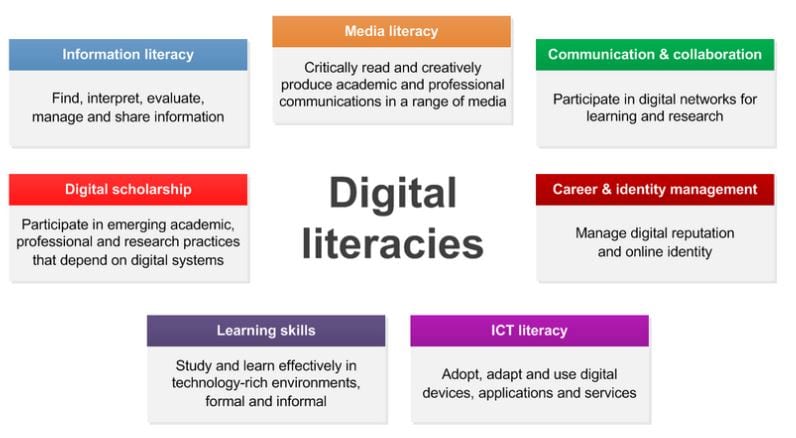October 2015
I’ve renamed this page e-teaching. This is the area of my research and just as much an elephant in the room. The literature on digital literacies and digital capabilities is as relevant for staff who teach and support learning as it is for students. Yet the focus of the sector has been on students as e-learners rather than staff as e-teachers. While institutions continue to promote the benefits of blended, flipped and flexible forms of higher education, it can be argued that e-teaching is implicit within e-learning. However, unless it is made explicit there is a risk those who are digitally shy or resistant will remain invisible. In which case the appropriate means of support and resources for those who haven’t yet found their digital feet is more likely not to be identified and provided.
From November the 1st I will be taking up a new post in the Technology Enhanced Learning Team at the University of Hull. If you are interested in the e-teaching side of e-learning please do get in touch. My email is s.watling@hull.ac.uk
Digital Literist page
Confidence working in digital environments is a prerequisite for teachings and supporting learning. Yet the required academic digital literacies are too often assumed with support coming from asking a friend or adopting a DIY approach. They are the proverbial elephant in the room. Everyone knows they’re there but no one wants to talk about developing or supporting them.
Issues include validation and authentication of online resources, digital identity and digitally inclusive practice as well as proficiency with tweeting, blogging and appropriate use of Facebook and other social media platforms. Academic digital literacies are incremental. Year on year brings more to keep up to date with. The learning curve increases. Like individual handwriting, the way we work online is unique to each person. Our virtual reality mirrors how we exist in the real world. There is no one size fits all model and very little joined up institutional support. I’s like to see mentoring systems between staff and students, BYOD sessions where people swap app usage to see how mobile technology might support teaching and learning environments and practice, more reference to ADLs in CPD accreditations processes. With the current interest in the principles of flipped learning and multimedia, the time for enhancing academic digital literacies has come.
Initially this is a signpost page.
Introducing digital literacies.
The SCONUL seven pillars of information literacy seen through a digital lens
http://www.sconul.ac.uk/publication/digital-literacy-lens
suggests criteria to Identify, Scope, Plan, Gather, Evaluate, Manage and Present digital information. Prescriptive rather than interpretative, it offers a useful indication of the breadth of digital literacies but leaves out the practical day-to-day reality of digital working practice.
Developing Digital Literacies
The current JISC definition: Digital literacies are those capabilities which fit an individual for living, learning and working in a digital society.
The Developing Digital Literacies Infokit http://www.jiscinfonet.ac.uk/infokits/digital-literacies/ offers a seven element model. It’s not clear where attention to digital divides and inclusion fits but being aware of potential barriers to access and participation must be included.

JISC Digital Media
The site at http://www.jiscdigitalmedia.ac.uk/ offers resources for finding, creating and managing still and moving images, audio and video.
UK PSF and the Digital University
Jisc and Professional Associations Guide to Implementing the UKPSF in the Digital University offers a useful framework to map digital capabilities against. https://ukpsfguide.pbworks.com/w/page/62948690/Home
Educational Development and Enhancement
Next academic year, the new Educational Development and Enhancement Unit at the University of Lincoln will look to providing additional support for virtual learning environments and developing the prerequisite digital confidence to use them effectively. Areas to provide resources around include:
- How to switch to html mode, what this means and what it enables the user to do (like embedding YouTube videos and adding dividing lines between paragraphs).
- Working with images. Optimising photographs to reduce their file size. Cropping a picture. Working with thumbnails. Inserting images in Word and PowerPoint. Resizing images on the page and for sending as email.
- Screen capture. Print Screen. Windows Seven Snipping tool.
- Producing and editing video with mobile phones, tablets and apps.
[contact-form to=’swatling@lincoln.ac.uk’ subject=’The Digital Literist ‘][contact-field label=’Name’ type=’name’ required=’1’/][contact-field label=’Email’ type=’email’ required=’1’/][contact-field label=’Comment ‘ type=’textarea’ required=’1’/][/contact-form]
image from http://en.wikipedia.org/wiki/File:The_Elephant_in_the_Room_Banksy-Barely_legal-2006.jpg
